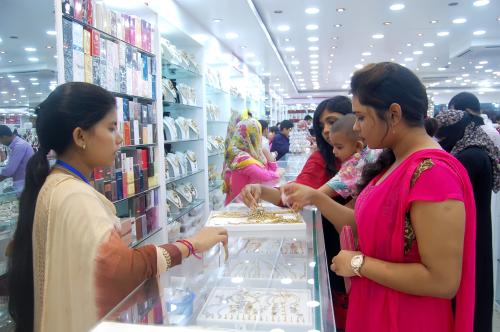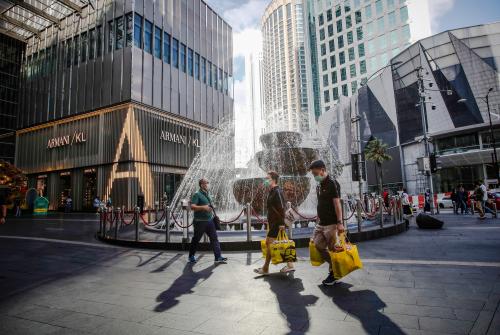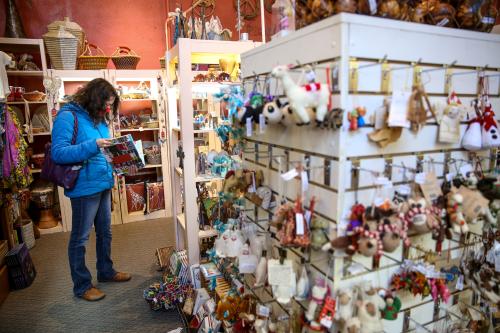Around the world, the middle class is expanding at a rate we have never seen before in history. Homi Kharas, a senior fellow in the Center for Sustainable Development at Brookings, joins David Dollar in this episode to discuss how that global middle class is defined and where growth is concentrated. Kharas explains how preferences among the global middle class will affect production, trade, regional value chains, and efforts to address climate change for years to come.
DAVID DOLLAR: Hi, I’m David Dollar, host of the Brookings trade podcast, Dollar and Sense. Today, my guest is Homi Kharas, a senior fellow in the Center for Sustainable Development at Brookings. Homi’s recent research focuses on the rise of a global middle class. Our topic is how this global middle class affects consumption, production, and trade. So welcome to the show, Homi.
HOMI KHARAS: Thanks so much, David.
DOLLAR: So let’s start with how you define the middle class. What does it mean not just in terms of income, but in terms of lifestyle and consumption?
KHARAS: Let me start by saying that how I define the middle class and how I measure the middle class are two quite distinct concepts. So I’d like to talk about defining the middle class in terms of a group of people who basically make choices about their lives and about the economics of their lives.
If you think about people, if you are poor, you don’t really have the ability to make choices. You just don’t have the discretionary income to go around. You are struggling just to make ends meet. If you are rich, you don’t have to make choices because you can afford pretty much anything that you want. And if you are in between, then you are making choices. That’s how I think about the middle class, and it’s consistent with this idea that the middle class feels a responsibility for themselves. It’s a very individualistic kind of concept. They take responsibility for their own well-being and for their families. They invest in themselves. So it’s really a group of people that are making those choices.
So how do we measure it, which is a slightly different thing? I try to choose people who are living in households that are spending between $11 and $110 per day per capita in 2011 purchasing power parity terms. That’s a huge mouthful; let me just give a very quick explanation. Purchasing power parity allows us to compare the middle class size across different countries both spatially and over time, so it essentially adjusts for price differences. The levels of the thresholds are levels at which we start to see, at the bottom level, for example, people not worrying about falling into poverty. The probability of falling into poverty if you are in a household spending more than $11 a day is less than five percent over three years. So you are actually actively thinking about how do I choose to spend my money. At the top end, it’s a fairly rough estimate about when is it that people literally don’t have to worry too much about a budget constraint; they can basically choose whatever they want. Then last, I would just say the reason why I talk about these things in terms of per person per day is because of the very long literature on defining poverty in terms of an amount that you spend per day.
Finally, let me say I think about the middle class in terms of expenditures rather than incomes because all of us know that you might be a student with a very low level of income today, but if you are in college you have a high future expected income. So your spending might be much higher because you can afford to take out student loans, maybe your family is helping you, all kinds of other things. You are living a lifestyle which is significantly different from the lifestyle of somebody who is really poor.
DOLLAR: Homi, in your research you argue that there are going to be big shifts in the global middle class over the next 10 years. Traditionally it’s been a mostly rich country phenomenon, but now we are going to see big shifts. So, can you characterize those shifts?
KHARAS: It’s really interesting to me that there are two very distinct narratives about what’s happening to the middle class right now. In advanced economies, which is where the bulk of the middle class used to be constituted—and certainly the first billion people in the middle class were almost entirely in Europe, North America, and Japan—the narrative is about how the middle class is getting hollowed out. What people are not really focusing on is that there is an emerging middle class, largely in Asia, which is expanding at a rate that we have never seen before in history.







Commentary
PodcastHow will the rise of the global middle class affect trade and consumption?
September 13, 2021